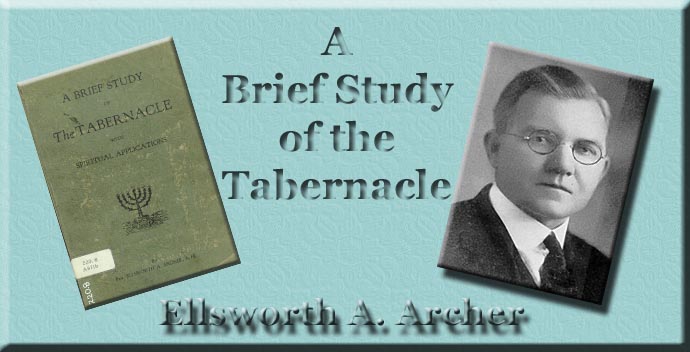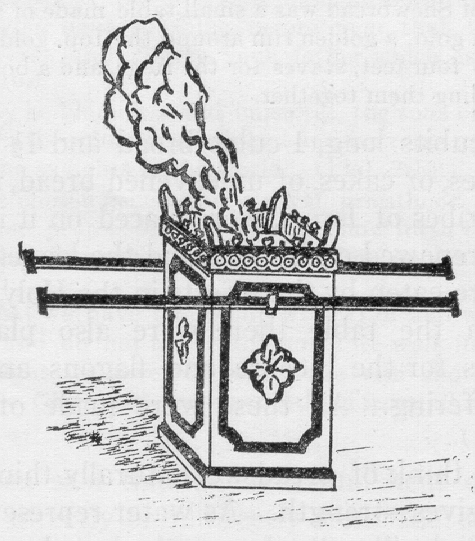
A Brief Study of the Tabernacle
By Ellsworth A. Archer
Chapter 9
|
THE ALTAR OF INCENSE.Ex. 30:1-11,34-38. The altar of incense was located in the Holy Place between the table of shewbread and the golden candlestick just before the vail which separated the Holy Place from the Most Holy. It was made of shittim wood overlaid with gold, and was 1 cubit (18 inches) wide, the same in length, and 2 cubits (3 feet) high. If it were divided in height it would form two perfect cubes. On each corner of the altar was a horn and each horn was covered with gold. These horns were sprinkled with blood by the high priest at the time of special sin offering, and on the day of Atonement. (Lev. 30:10.) Around the top of the altar was a border of gold which was called a crown or wreath. There were two wooden staves, overlaid with gold, passing through golden rims, by which the priests carried the altar on their journey. (Ex.30:1-6) At the beginning of the morning and evening service, the high priest offered incense of sweet spices on this altar. (Ex. 30:7, 8.) The incense was most costly and precious, and by divine command it could not be made or used for any other purpose. The penalty for so doing was as follows:
The time for offering the incense was the hour of public prayer. (Luke 1:10.) Incense in the Bible is used to represent prayer. (Psa. 141:2.) The fire for burning this incense was carried from the brazen altar which stood before the tabernacle, and no strange fire was to be offered thereon. At one time Nadab and Abihu, the eldest sons of Aaron, endeavored to offer strange fire upon this altar and were stricken dead before the Lord. (Lev. 10:1, 2.) There are some priceless and spiritual lessons which may be learned from this altar, a few of which we will consider. Bearing in mind that this incense altar represents prayer, let me call attention to the significance of its location just before the vail which separated the Holy from the Most Holy Place. As the incense from it went over and around the curtain into the Most Holy Place where dwelt the presence of God, so our prayers enter through the vail into Heaven and bring us into the very presence of God, and we have communion with Him. Another impressive thought in connection with this altar is that it represents Christ's prayers. He is our perfect example of prayer. All through His life He prayed. Had you noticed how the greatest triumphs of His life came after much prayer? His important works were preceded by prayer. He prayed before He chose his twelve apostles and before He preached the great Sermon on the Mount. (Luke 6:12,13, 20.) He prayed before He was transfigured. (Luke 9:28, 29.) He prayed in the Garden. (Matt. 26:36, 39, 42, 44.)
Yes, and on the cross he prayed, "Father, forgive them; for they know not what they do. (Luke 23:34). In His last hour of bitter anguish He even intercedes for His enemies; and now "God hath highly exalted Him, and given Him a name which is above every name," (Phil. 2:9), and He is at the right hand of God, where He continues to make intercession for all mankind.
Notice that this altar was the highest piece of furniture in the tabernacle. It was half a cubit higher than the table of shewbread and the ark of the covenant. Thus prayer is the most exalted service that one can perform. When one really prays he is higher than at any other time. Let no one who truly prays say that there is nothing he can do, for this ministry is second to none. Tennyson says that more things are wrought by prayer than this world dreams of.
Prayer does not change God, but prepares us to receive the things prayed for. "To pray is to desire; but to desire what God would have us desire."
Again, this altar had four horns-one for each corner pointing to the four great camps of Israel and to the four points of the compass-north, south, east, and west. The prayers of Christ encompass the whole world; His gospel is a universal message which includes all mankind. So our prayers should include the whole world. We are far too much inclined to be selfish in our praying. We pray for ourselves, our loved ones and our own interests but forget the rest of the world. The best way to get help ourselves is to pray for others. Many a victory is gained for self by praying for someone else. Shall we not form the habit of thinking of others?
It is possible to have sheaves from Africa, India, China, Japan, and the islands of the sea, even though we remain in America, if we only pray. There are preaching evangelists, and singing evangelists--how about some praying evangelists? Each of us can be one if we will. Another important thing in connection with prayer is regularity.
Note first, that this incense was burned regularly every morning and evening, and that the odor filled every part of the tabernacle. It is a great help spiritually to have a regular time to pray. If we do this we can actually store up strength against the "evil day." If prayed up, when temptation comes we will be able to stand. If not prayed up when temptation comes we are apt to be overcome. Faithfulness in prayer is a great means of strength.
Notice second, that this incense was perpetual, and filled the room continually. So should we "Pray without ceasing." (1 Thes. 5:17.) "But," says some one, "I can't pray all the time and do my work." No, not audibly, but you can have communion with Christ and be in a SPIRIT of prayer continually. If you were in a room where there were fragrant flowers you would be conscious of the perfume from them even though you were working. So is Christ with us. We can feel His presence and commune with Him through the pressure of work and the cares of life. The consciousness of this communion lightens the labor, brightens the dark places and gives courage and strength for the daily tasks.
There were rings on the altar through which to run the staves that it might be carried whenever the tabernacle was moved. It was not stationary so that the people had to make pilgrimages to it, but it went with them. So we may take our altar of prayer wherever we go-at work, at play, at home or at church. Have you the rings and the staves in the rings? Have you learned the secret of praying anywhere?
The incense, which was an example of the bloodless offering, was compounded of four ingredients, namely: stacte, onycha, galbanum, and pure frankincense, beaten small. (Ex. 30:34-36.) Great care was taken in its preparation. Some authorities claim that it is not known what the first three ingredients are, but all agree upon the frankincense. However, some think they were as follows: That stacte was probably the gum from a plant about six feet high like a quince, called the storax tree; that onycha was the covering of a shell fish which was found in the Red Sea. This ingredient did not give a pleasing odor by itself but it gave strength and continuance to the other perfumes. That galbanum was the resin from a shrub which grew on the Syrian mountains. It had a strong disagreeable odor by itself but when mixed with the other perfumes it added to their sweetness. The frankincense was the gum of an Arabian tree which was valued very highly for commercial purposes. Notice that these ingredients were beaten very small:
Get this thought (for us) that there is no petition too small to bring before our Father in Heaven, no heartache or trial too small for His notice, even though we may sometimes feel our prayers are not heard. But not so. Listen to what the Revelator says:
Thus the prayers that we feared forgotten or unheeded are preserved. Our Father remembers; He will not fail us; He will not forget us. He does hear and answer prayer.
|
|
 |
 |
|
|
|
-
Site Navigation
 Home
Home What's New
What's New Bible
Bible Photos
Photos Hiking
Hiking E-Books
E-Books Genealogy
Genealogy Profile
Free Plug-ins You May Need
Profile
Free Plug-ins You May Need
 Get Java
Get Java.png) Get Flash
Get Flash Get 7-Zip
Get 7-Zip Get Acrobat Reader
Get Acrobat Reader Get TheWORD
Get TheWORD
